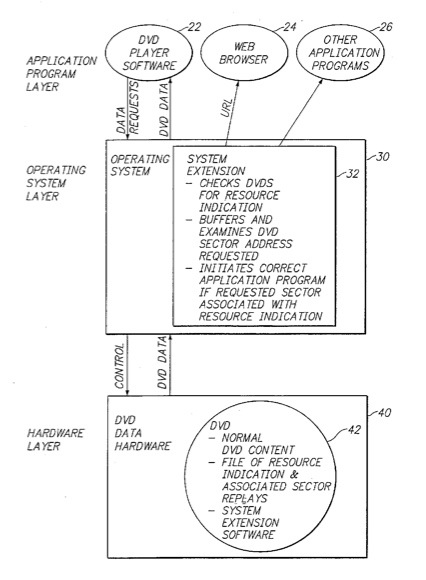A new Apple patent (number 20100278513) at the US Patent & Trademark Office shows that the company is looking for ways to make it easier for Macs to read commercial DVDs. The patent involves embedded access information for DVDs independent of the DVD player software.
Per the patent, an operating system extension is used to implement embedded information on a DVD. The operating system extension examines DVD sector addresses requested from the DVD hardware. When address associated with an embedded link is requested, an application program that can run the embedded link is started, and the embedded link is provided to the application program.
The system of the present invention has the advantage that it does not require modifying the DVD software program and thus can be used with a variety of different DVD software programs. The inventors of the patent are Freddie Geier and Stefan Bauer-Schwan.
Here’s Apple’s background and summary of the invention: “The Digital Versatile Disc (DVD) is a high-capacity multi-media data-storage medium designed to accommodate a complete movie on a single disc, content-rich multi-media or very high-quality multi-channel audio. DVDs have become quite popular, the market for DVD having grown faster than compact discs (CDs) or VHS video cassettes did during their first two years.
“The most popular of the DVD formats is the DVD-VIDEO format, which is a format for video content which can be played on domestic DVD players and DVD-ROM drives. The DVD-ROM format is for delivering data and multi-media content which can be played by computers equipped with DVD-ROM drives.
“DVD-ROM drives are becoming quite popular and are now standard on many high-end computers. Typically, the DVD-ROM hardware is accessed by the peripheral device access functions of the operating system. The data from the DVDs is provided to DVD player software. The DVD player software allows the computer user to access the various content of the DVD. One popular use of DVDs for computer-based systems is for displays and presentations by companies to potential customers and employees.
“The DVD players and discs operate in accordance with the official DVD specification, currently the DVD video specification version 1.1. The official specification was developed by a consortium of ten companies: Hitachi, JVC, Matsushita, Mitsubishi, Philips, Pioneer, Sony, Thomson, Time Warner, and Toshiba. Representatives from many other companies also contributed in various working groups. In May 1997, the DVD Consortium was replaced by the DVD Forum, which is open to all companies, and as of February 2000 had over 220 members.
“A difficulty with DVD systems is that they do not allow access to information other than that stored on the DVD. Once a DVD is produced, the content of the DVD can not be updated. It is desired to have an improved DVD system that allows access to the information not stored on the DVD itself.
“The present invention uses embedded information in DVDs to obtain resources outside of the DVD. The embedded information preferably uses use resource indications such as Uniform Resource Locators (URLs) or a file indications. The resource indication is used by an application program to access the resource. This resource (such as a web page) can contain the most current information.
“In a preferred embodiment, the embedded information is supported by the operating system, preferably an extension to the operating system. The operating system, in a preferred embodiment, checks the DVD for resource indications and associated sector address regions when the DVD is placed into the hardware player. The resource indications and associated sector address regions are preferably stored in a portion of a DVD file, such as the Video Title Set navigation information file — ‘VIDEO_TS.IFO’.
“The resource indications and associated sector address regions are stored on the DVD in a manner that they are ignored by systems that do not support embedded information. In one embodiment, the resource indications and associated sector address regions are stored in a vendor specific field of a text portion of the file. Other DVD players will not access this vendor specific field.
“When the DVD is played, the operating system examines all requested sector addresses of DVD data for addresses associated with one of the resource indications. If an association is found, the operating system starts an application program and provides the one of the resource indications to the application program to obtain a resource. Since the requested address are examined by the operating system, the starting and resource-indication-providing steps need not done under the control of DVD player software.
“Having the operation of the system of the present invention independent of the control of a DVD player software is advantageous. One way to support embedded information for DVD is to have the DVD player software modified to support such embedded information. The problem with modifying the DVD player software is that it requires such DVDs with embedded information to be used only with the DVD player software systems that support embedded information.
“Thus the embedded-link system would not work with all of the DVD player software that supports the DVD specification. By using operating system software, in particular operating system extension software, this problem is avoided. The system of the present invention can be used with a variety of different DVD player software systems without requiring any modifications to the DVD player software.
“In one embodiment, the resource indication is stored in a text portion of the DVD and associated with a sector address range on the DVD. When the operating system requests DVD data from a sector address range, the operating system starts the application program and provides the resource indication to the application program to obtain the resource. This operation can be done at any time during the operation of the DVD.”





